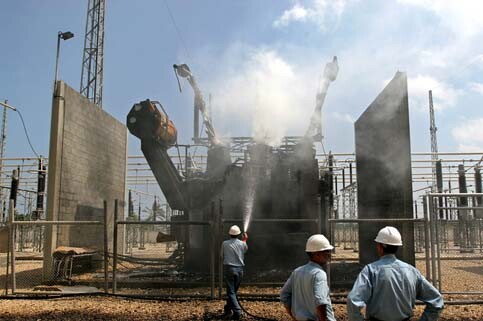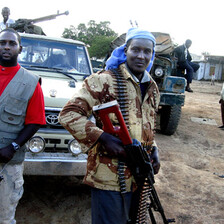The Electronic Intifada 1 July 2006

Palestinian electricity workers extinguish a fire inside the headquarters of the main electricity company in the Gaza Strip after it was attacked by an Israeli missile during air strikes over the city, June 28, 2006. (MaanImages/Wesam Saleh)
It would be too simple to sum up Israel’s recent military incursions in Gaza as a humanitarian disaster. “It is infrastructural warfare,” remarked Jad Isaac, director of the Applied Research Institute of Jerusalem (ARIJ), this morning, referring to the obliteration of Gaza’s bridges and power stations, or what the Israeli army calls “terrorist infrastructure”. Last Friday, the World Food Program’s (WFP) Arnold Verken warned that the destruction of Gaza’s electric grid would quickly lead to hunger and food shortages, as the already impoverished 1.3 million Gazans lose their basic services - it does not help that their borders are closed too.
The above assessments are the typical, practical reactions of those who task themselves with providing immediate needs: ARIJ is presently trying to organize an NGO collective that will breathe life back into Gaza when the smoke clears; the WFP and its humanitarian counterparts are advocating for a cessation of violence and the movement of basic goods.
But beneath the immediate surface are those who task themselves with generating a meaning where actions are inexplicable. Among them are the mainstream U.S. media, who squeeze water from stones, invoking the pretense of Qassam rockets - the latest fetish symbol of Arab confusion and savagery since suicide bombs - and now the youthful face of kidnapped[*] Corporal Gilad Shalit, whose picture has become an exploitative reminder on nearly every Internet news story related to Gaza, whether it mentions him or not. And as humanitarian agencies tailor their statements to be “even-handed” toward occupier and occupied, U.S. media reports are bereft of the names, faces and stories of the children held under Israeli administrative detentions, which are by any measure illegal.
Rather, journalists such as Time’s Tony Karon re-imagine Israel’s “moral burden” to occupy Palestine; the Associated Press’ Alexander Higgins refers to Israel’s human rights abuses as “alleged”; and U.S. officials accuse the UN Human Rights Council’s review of Israel’s conduct of being “misguided and unfair”. One cannot be blamed for inferring that U.S. power elites and certain media pundits have a shared interest in maintaining imbalanced perspectives on Israel. This coincidence is particularly startling given the Western media’s proclivity for numbers, and the reality that Shalit accounts for the one Palestinian-held Israeli political prisoner, compared to the nearly 9,600 Palestinian prisoners, who include women and children, held by Israel.
It comes then as some surprise that Israel’s own Haaretz today ran a scathing editorial of Israeli military exploits in Gaza, in which it skeptically stated, “The government wishes to convince us that all these actions are intended only to release the soldier Gilad Shalit.” Based on the footage of incinerated buildings in Gaza, Shalit may have already become the victim of a feckless Israeli “liberation” campaign - he wouldn’t be the first such Israeli.
To any critical eye on this region’s affairs, the farce was apparent early on, when Israeli Prime Minister Ehud Olmert held Palestinian National Authority President Abu Mazen (Mahmud Abbas) directly responsible for Shalit’s abduction - in reality, Abu Mazen has no more control over Palestinian militants than Brad Pitt has over world poverty, no matter how many Kalashnikovs Israel supplies his factions (i.e. Abu Mazen’s). One might argue that even earlier signs were evident when Olmert explicitly stated that the safety of Israeli citizens was “even more important” than that of Palestinians.
This is not to place too much importance on conjecture, but to insist on deconstructing the reality that is Israel. That perspective begins with a critical reading of history and an attentive ear to the plight of its victims. The Palestinian narrative is essential to this understanding, but so too is that of the Israelis. While Palestinians are subjected to, and, in later cases, engage in the physical violence of Israel’s colonialism, it is the Israelis who are pawns of the Orwellian infoplex that maintains the state’s normalcy.
In undressing these realities, one is tempted to recall the racist affirmations of leaders like Yoram Bar Porath, who in 1972, told Yediot Aahronot, “It is the duty of Israeli leaders to explain to public opinion, clearly and courageously, a certain number of facts that are forgotten with time. The first of these is that there is no Zionism, colonization, or Jewish State without the eviction of the Arabs and the expropriation of their lands.”
One is also tempted to recall the corruption and mis-leadership of Yasser Arafat, who bowed to demands to recognize Israel’s existence, in exchange for a process that transformed the Palestinian liberation agenda into a proxy for Israel’s colonial security. The recent accord between Hamas and Fateh to recognize Israel will likely bring no greater dividends to Palestinians than Arafat’s former attempts, and they certainly will not bring an end to re-invasions of Gaza, as Olmert has said himself.
The frequency and obsession with which people debate Israel’s right to exist lead one to wonder why Israel has such a strained time of making itself philosophically valid. Rather than debate the morality of recognizing or not recognizing Israel’s right to exist, we should instead look at the manner in which Israel has existed, both in thought and practice.
According to Israeli peace activist and writer, Michael “Mikado” Warschawski, a major point of contention that has plagued the Zionist project is the line between Israel’s “continuity” and “contiguity”. Recognizing that an outright transfer, or ethnic cleansing, of all remaining Palestinians would stain Israel’s image, throughout the past two decades, Ariel Sharon and other policymakers concocted a new vision for Israeli space. Merging the Zionist expansionist desires of Eretz Israel (greater Israel) with that of separateness and homogeneity, Israel was re-envisioned as a “continuous” nation connected by roads, inhabiting a physically higher plane than its Palestinian counterparts. This obsession with separate existences ensures a “continuity” of Jews on one plane, and a “continuity” of Palestinians on another, with the two being “contiguous” entities (i.e. side-by-side), yet disconnected. In this vision, space mattered but people did not.
In 1998, at the culmination of this strategy Sharon told Agence France Presse, “Everybody has to move, run and grab as many hilltops as they can to enlarge the settlements because everything we take now will stay ours… Everything we don’t grab will go to them.”
This is why one is hard-pressed to discover a prominent hilltop of arable Palestinian land that is not staked out with an Israeli military garrison, watch-tower, gas station, settlement or settlement outpost. It is why, using walls and barriers, Israel inflicts itself with mild ghetto-ization to afford Palestine’s extreme ghetto-ization, along with the notion that this somehow makes life better. It is why Mikado can stand at an Israeli-only highway gas station and point to two distant modern hilltop communities to his north and south (both inside the West Bank), interspersed by yet more carved up Palestinian villages below, and say, “those hilltops, that road, this gas station, and all the space in between are technically one large settlement.” It is also why al-Multaqa’s lead advocate, Ahmad Rwaidy, recently told me, while we were interrogated at a checkpoint on that same road, “It is all psychological. The Israeli soldiers need to pretend, again and again, that things like this are necessary. Why else would this checkpoint be un-manned on Saturdays?”
But there is nothing new to Israel’s spatial configurations. In 1958, Israeli General Yigal Allon wrote that the original aim of Zionism was to “establish a chain of villages on one continuous area of Jewish land.” Even before Allon’s time, Zionist ideologue Theodore Herzl, argued that “the idea of Zionism, which is a colonial idea, should be easily and quickly understood in England.” Britain’s enthusiastic endorsement of Herzl’s idea was evident even before the 1917 Balfour Declaration, when their government released a 1915 memorandum proposing “the British annexation of Palestine [where] we might plant 3 or 4 million European Jews.”
And how do these matters come full circle to the present collective punishment of Gazans, or to the abduction of democratically elected officials in the West Bank? On Friday, Haaretz reported that the Yesha Council of settlements had obtained funding for free transportation between several colonies throughout the West Bank. The Council told Haaretz it had acquired these measures “in coordination with the Israel Defense Forces, to cover hitchhiking posts at settlement entrances.” Never mind that these settlements are illegal, and that the “Defense Forces” protecting them serve the role of a colonial militia. Israel is about space, not people, at least until the Palestinians are gone.
We look now to Gaza, to see what our pundits imagine next. Did the “IDF” really come here for Shalit?
[*]Editor’s Note: The dictionary definition of the word “kidnap” necessitates that the abduction of a person is illegal. As the Israeli soldier was part of an occupying force, captured during a military raid against a military target, in international law he is considered to be a “prisoner of war”, not a kidnap victim. The rules governing the treatment of prisoners of war are spelled out in the third Geneva Convention of 1949, article 13 of which requires that POWs “must at all times be treated humanely”.
Zachary Wales is a regular contributor to Electronic Intifada.
Related Links




